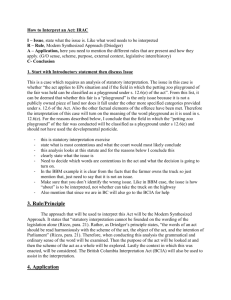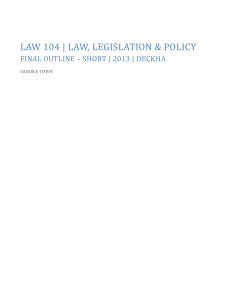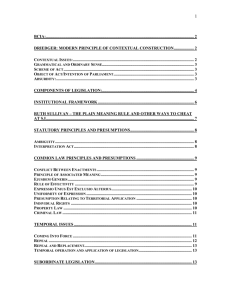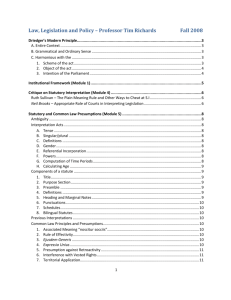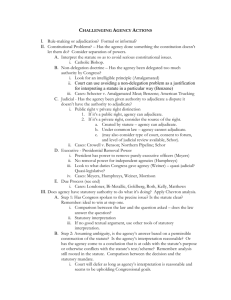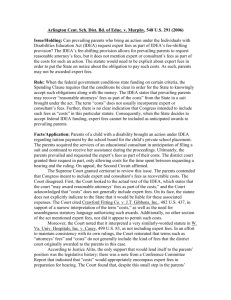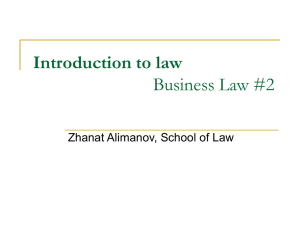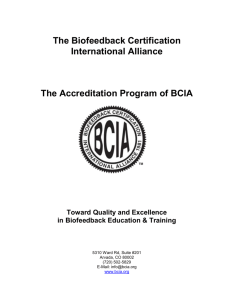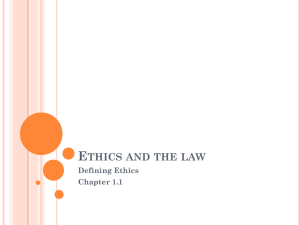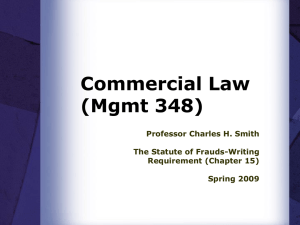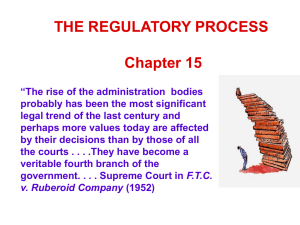LLP Final Outline
advertisement
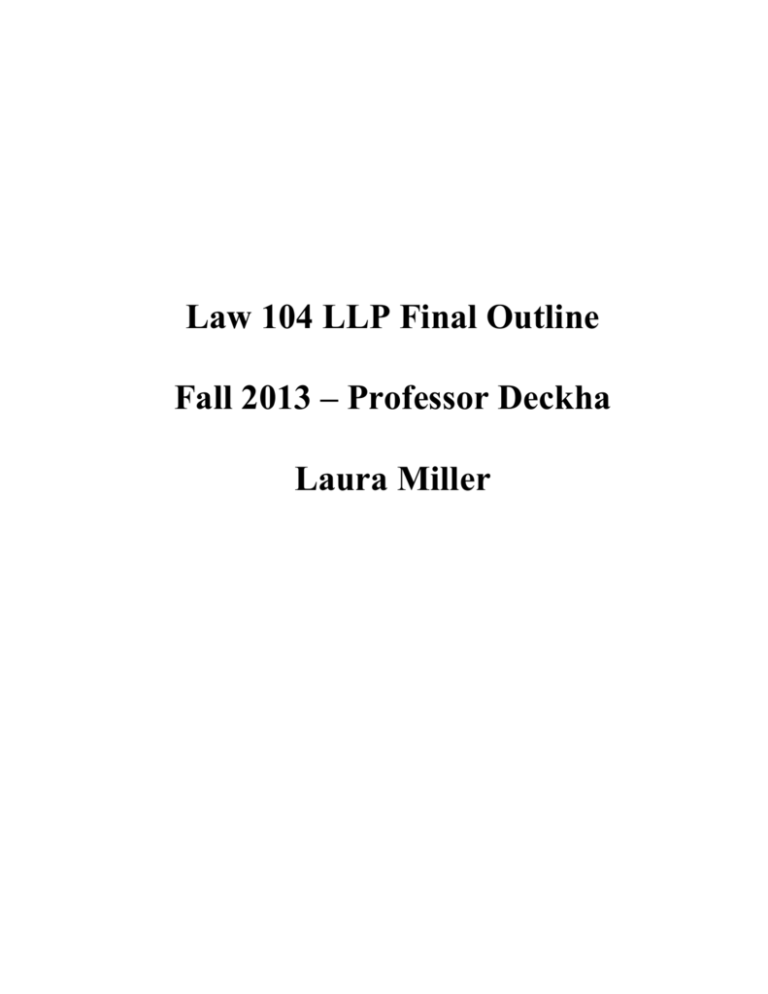
Law 104 LLP Final Outline Fall 2013 – Professor Deckha Laura Miller Statutory Interpretation 1.) Historical Approaches Heydon’s Case (1584) – Interpretation relies on: Common law before the existence of the statute What is the mischief that the common law did not cover The remedy provided by parliament The true reason for the remedy Judges are to suppress the mischief and advance the remedy Sussex Peerage Case (1884) and Grey v Pearson (1857) Strict construction advocated for Golden Rule of literal construction: “a statute should be interpreted in a manner consistent with the plain meaning of its terms” (Lamer, 1995, McIntosh) 2.) Drieger’s Modern Approach “Today there is only one principle or approach, namely, the words of an Act are to be read in their entire context and in their grammatical and ordinary sense harmoniously with the scheme of the Act, the object of the Act, and the intention of Parliament” Seen in McLachlin’s dissent in McIntosh (1995) Adopted by the SCC in Rizzo (1998) Factors set out in Merk for the Modern Approach Grammatical and ordinary sense – does anything in this clearly preclude one interpretation? The scheme of the act – What type of statute is it? The object of the act – Legislative Intent The public policy debate – what are the social ramifications of the different interpretations Avoidance of anomalous results – interpretations that give rise to irrational results are to be avoided Legislative history – looks at the statutes that gave rise to this one, includes amendments Penal provision – Holds little weight now and does not apply to regulatory statutes Rules and Tools of Statutory Interpretation Administrative Interpretations: Courts will sometimes show deference to the interpretation of an administrative tribunal, as they are specialists in the area. Associated Meaning (noscitur a sociis): a word takes its meaning from the surrounding text o Used in McDairmid Lumber v. God’s Lake First Nation Anomalous Results: interpretations with irrational results should be rejected o Seen in Merk and Sullivan and Driedger on the Construction of Statutes o Lamer in McIntosh saw no problem with absurd results (outdated) Bilingual Statutes: When there is a conflict between the English and French meanings the narrower definition is used o Medovarski v Canada Crown immunity, Presumption of: CIA s17 states that “no enactment is binding on Her Majesty or affects Her Majesty’s rights or prerogatives.” o BC does NOT use this: BCIA s14 states that “Unless it specifically provides otherwise, an enactment is binding on the government” Definitions: ‘means’ indicates an exhaustive definition, ‘includes’ does not o Convention used in BCIA s29 definitions o Regina v Riddell et al: Legal dictionaries are better than regular ones o in pari materia – when there is a definition in legislation from the same government on the same topic it is very persuasive Extra-territoriality, Presumption against: presumption that laws do not apply out side of the jurisdiction of the legislature that enacted them. o There is also the real and substantial connection test for Canadian law to apply Hansard Evidence: may be used in discerning legislative intent (part of LH) but is considered frail evidence o Used in Rizzo o Used in Re Firearms Act Historical Context: Using facts from the time in which the legislation was enacted to aid in interpretation. As a part of this a court may also take judicial notice of well-known facts. Human rights legislation: must be given an especially broad and purposive interpretation as the goal is to preserve human dignity and prevent discrimination (School District No. 44 v. Jubran) Implied Exclusion (expressio unius est exclusio alterius): when the legislature mentions one thing it automatically excludes all others. o University Health Network v Ontario o Rebutted in C.R et al v Children’s Aid Society of Hamilton Legal Meaning of Words: If words have a standard legal meaning this is used over the common meaning (Merk) Legislative Evolution: Previous versions, amendments and transitional provisions can indicate legislative intent. – Rizzo o Note BCIA s37 and CIA s.45(2) – amendment does not mean change in meaning as they can be substantive or declarative! o Re Simon Fraser University and the District of Burnaby – uses this Legislative History: Extrinsic evidence which can contribute to legislative intent o Alternate draft versions (Mowat) o Comparisons to old legislation on the subject (Merk) o Hansard, briefing notes and house committee reports Limited Class Rule (ejusdem generis): when there is a list with a catch all category it is limited to the type of things contained within the list. o Used in Nanaimo (City) v. Rascal Trucking Ltd Municipal Laws: Previously interpreted using strict construction, now viewed more broadly (United Taxi) Ordinary Meaning: What would the reasonable person of average intelligence and understanding take the word to mean? o Driedger concept “grammatical and ordinary sense” o Shaklee Canada Inc v Canada: ordinary meaning is not always what is found in a dictionary o Terms of Art retain their legal meaning – Mowat ‘costs’ Penal Provision: where two interpretations of legislation are available the one more favourable to the accuse will be used o Relied on by Lamer in McIntosh o Does not apply to regulatory statutes (Merk) o Now holds little weight as established by SCC in Merk o Also rejected in R v. Hasselwander for criminal law. Here the court looked to the goal of prohibiting certain weapons not the strict meaning Plain Meaning (aka the golden rule): When words are “clear” there is not need to consider context o Used by Lamer in McIntosh o Now seen a incomplete, Rizzo Property Rights: It is assumed that the legislature does not intend to interfere with property rights o Commonly seen expropriation where it is assumed that the government intends to compensate for expropriated land – Dell Holdings o Also preserved in Charter s8 o Was previously used to give a strict interpretation to taxation statutes but now the Modern Approach is used. Punctuation: It is given very little weight especially when it would give rise to anomalous results o R v Jaagusta and R v Popoff Remedial Provision: every act shall “receive such fair, large and liberal construction” o BCIA s8 and CIA s12 o Used in Re Rizzo & Rizzo Shoes Scheme Factors: o ‘Benefits Conferring’ Legislation: “any doubt should be resolved in favour of the claimant” (Merk) o Human Rights Legislation: large and liberal construction due to quasi-constitutional status (Mowat) Tautology, Presumption against (Rule of Effectivity): Words used in a statute are put there for a specific purpose and should not be assumed to be redundant o Exception is the ‘shopping list’ or ‘scattergun’ approach to cover every conceivable situation known as ex abundanti cautio (abundance of caution) o Used in Canada (CHRC) v Canada (‘Mowat’) and McDiarmid Lumber v God’s Lake First Nation Tax Laws: Historically used strict construction in favour of the tax payer but are now analyzed using the Modern Approach (Placer Dome) Uniformity of Expression: the same word has the same meaning throughout a statue and when different words are used they are presumed to have different meanings o Set out in Schwartz v Canada 3.) Components of a Statute Title: Is relevant in statutory interpretation as it is democratically enacted. Common law authority: R v Lane and Committee for the Commonwealth of Canada v Canada (AG) Statutory authority: BCIA s9, not mentioned in CIA Preamble: Useful in showing legislative intent. Not all legislation has a preamble. Democratically enacted Common law authority: Re Anti-Inflation Act Statutory authority: BCIA s9, CIA s13 Headings: Sub-titles within a statute. Frail evidence but better that marginal notes Common law authority: R v Lohnes and R v Basarba Statutory authority: None Charter headings are apart of the document and democratically enacted (R v Wigglesworth) Marginal Notes (and head notes): added editorially for convenience only Common law authority: Used in McLachlin’s dissent in McIntosh, R v Basaraba says not to use them Statutory authority: BCIA s11(1) says NOT to use head-notes, CIA s14 says NOT to use marginal notes Schedules: An appendix flowing the statute including things such as house forms which would clutter the statute. Are apart of the statue and may be used but given less weight than the body of a statute Common law authority: Houde v Quebec Catholic School Commission Statutory authority: None 4.) Coherence (Part of Scheme) Internal Coherence: The provisions of a piece of legislation are meant to be read together and function as a whole Horizontal Coherence: A legislative body is presumed to be speaking with one voice, which results in the interpretation of one statute being able to be aided by others from that same body. o Referential incorporation see BCIA s44 o This tool is strongest when legislation is in pari materia, deals with the same subject matter. o Can be seen in Columbia River & Property Protection Society and East Kootenay Environmental Society v. British Columbia Conflicts between enactments from the same legislative body: o The more recent statute will be used over an older one o The more specific statute will be used over a broader one o When first two provision are in conflict specificity is used over age o In Lewis v. Fraternite de Policiers the more recent and more specific statute is used over an older more general one Vertical Coherence: o All legislation much be consistent with the constitution and the Charter However use of Charter values in SI is less clear. R v. Gomboc states it should only be used for true ambiguity at the end of SI. R v. Tse states that it should be used in each step of analysis. o Paramountcy of federal over provincial legislation o Human rights legislation is seen as quasi constitutional and takes priority when it conflicts with other legislation Stated in BC Human Rights Code s4 Insurance Corporation of British Columbia v. Heerspink states this in a case where there is not any statutory authority o Subordinate legislation must be consistent with the enabling act and all other statutes unless it is clearly stated otherwise o Reference to international legislation: Treaties and other international agreements signed by Canada can factor into SI. In Baker v. Canada the Immigration Act was read to be consistent with the UN Convention on the Rights of the Child. 5.) Temporal Applications Coming into Force Enactment is when a statute receives royal assent, thus completing the legislative process Commencement is when a statute comes into force as law o BCIA s. 5(2) states that when an Act does not have an expressly stated commencement date it is assumed to be when the act receives royal assent (which is the same time as enactment). Timing of commencement / repeal is laid out in the BCIA o s. 4(1) – an enactment comes into force at the beginning of the day that it comes into force o s. 4(3) – an enactment stops having affect on the end of the day that it is repealed o s. 4(2) – for repeal and replacement the old statute stops being of force when the new statute commences Changes to legislation * Note there is uncertainty in some areas on this from the BCIA * Expiration: occurs when a statute no longer has practical significance. o Expo 86 Act was not repealed until years after the event ended o BCIA s. 4(4) states that a statute that no longer has an effect is deemed to be repealed. Amendment: changes to a statute that may take many different forms o BCIA s. 37(2) states that amendments cannot be assumed to be substantive. They also cannot be assumed to be declaratory Repeal: Principles set out in BCIA s. 35 o BCIA s. 35(1)(a): the Common Law in an area does not come back into force if an enactment is repealed o BCIA s. 35(1)(b): Acts that were lawful under the repealed statute that occurred when it was in force cannot be challenged. o BCIA s. 35(1)(c): repeal does not affect accrued or accruing rights o BCIA s. 35(1)(d): repeal does not affect offences committed when the act was in force subject to s. 36(1)(d) o BCIA s. 35(1)(e): proceedings relating to vested rights or offences can be continued, initiated or enforced following repeal subject to s. 36(1) as stated in s. 35(2) Repeal and Replacement: Principles set out in BCIA s. 36, but since it also involves a repeal s. 35 applies too. LOOK CAREFULY AT BOTH ACTS o BCIA s. 36(1)(a): personnel appointed under the old enactment continue to serve as if appointed under the new one o BCIA s. 36(1)(b): proceedings in progress will continue with procedures from the new enactment o BCIA s. 36(1)(c): new procedures are to be used o BCIA s. 36(1)(d): when there is a mitigated penalty in the new enactment it is to be used for any punishment imposed following the replacement – this includes proceedings in progress and offences committed under the old act. o BCIA s. 36(1)(e): regulations made under the old statute continue to be in force so long as they comply with the new one o BCIA s. 36(1)(f): any referential incorporation referring to the old statute is deemed to be a reference to the new statute. Presumption against retro application: o Retroactive: when a law imposes past consequences to past action. Presumption against this is strong. o Retrospective: when a law imposes new future consequences to past actions. There is a presumption against this but it is weaker. Presumption stated in Gustavson Drilling o This can often depend on the characterization of events. There is no problem with immediate application for events in progress. o Mackenzie v. British Columbia shows the presumption against retrospective application rebutted o The presumption against retrospective application does not apply to procedural, beneficial or protective laws (Sullivan). Presumption against interfering with vested rights: stated in Gustavson Drilling. Only applies when there is no clear intent by the legislature to affect rights. o “Concrete rights definitively acquired by the person before the legislation came into force” – Sullivan o “legal situation must have been sufficiently constituted at the time of the new statute’s commencement” – Dirkranian quoting Cote. o Accruing rights protected in Scott v. College of Physicians and Surgeons. Test was that he had taken substantial steps. Sullivan’s Steps for Temporal Analysis: Establish the coming into force date Identify the key facts Situate the facts in time Determine if the facts were complete, ongoing, or not yet commenced when the provision came into force Determine whether applying the provision would interfere with vested rights If there is retro-application or vested rights are there grounds to rebut the provision. 6.) Subordinate Legislation Step 1: Subordinate Legislation vs. Administrative Instruments Making this distinction is the first step in analysis because administrative instruments are not subject to judicial review – Re Friends of the Oldman River Society the guidelines order was found to be subordinate legislation due to formality of the language and procedure (shall) Subordinate legislation is delegated to other bodies but has the same force of law as primary legislation o Includes: regulations, orders, decrees (Quebec Only), rules, tariffs, by-laws, letters patent o As per the definition of enactment in s1 the BCIA applies to regulations. Administrative instruments are not legally binding but often have significant affects o Includes: guidelines, policies, manuals, directives o Important to ensure consistency in how the law is applied by civil servants Step 2: the Statutory Source of Authority Regulations must be authorized explicitly by a statutory authority in the enabling clause. BCIA s 41(1) always applies to regulatory powers o 41(1)(a) – regulations that are necessary, advisable, ancillary and not inconstant with the enabling statute o 41(1)(b) – for procedural or administrative matters for which no express or partial provision already apply Look for any limitations to the regulatory power Step 3: BC Regulations Act (CB 6-21 to 6-23) Only applies if the word “regulation” “prescribe” “prescribes” or “prescribed” is found in the enabling clause – BCRA s. 1 Lays out procedural requirements to assist with transparency Step 4: Does the enabling clause authorize this specific legislation BCIA s 41(1) supplements the regulatory power. This will involve a purposive analysis of the enabling statute De Guzman: in the case of framework legislation regulations are rarely found to be invalid Anti-Poverty: regulation was found to not be authorized by the statute despite a broad enabling clause when the act was read as a whole. Constitutional Limits: Parliament must remain supreme o Henry VIII clause is when the parent statute authorizes regulations to change parent statute o Applies to Henry VIII clauses; however they have been found to be constitutional both in war-time (Re Grey) and in peace-time (Waddell). Must be clearly stated so it is clear the parliament intended to allow this.
